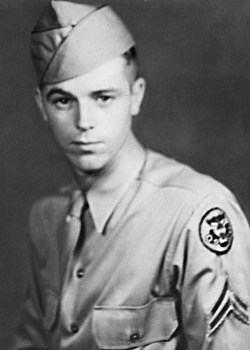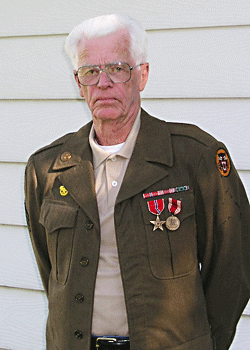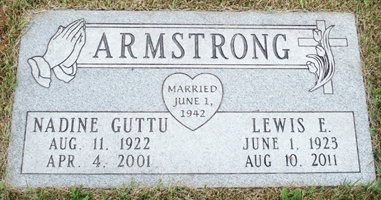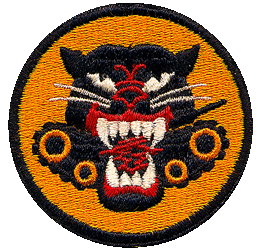 Lewis E. Armstrong
Lewis E. Armstrong
Biography: Lewis Errol Armstrong was born on June 1, 1923, in Nashua, Montana. He was the eighth of nine children born to Andrew F. Armstrong and Hazel Jackson, who were pioneers and homesteaders in the state. When the depression hit, the family moved to Fort Peck, where Lewis attended high school and was interested in sports, excelling at basketball. He later graduated from Glasgow High School.
Prior to the war, he worked as a delivery boy for Buttrey’s Foods. He may have also worked as a sales clerk, as indicated by his enlistment record. Shortly after Pearl Harbor was attacked, Lewis met the former Nadine Margaret Guttu who was born in Carbury, North Dakota and was the daughter of Sigvald Fredrik Guttu and Signe Carolina Sperre. The couple would marry on Lewis’ birthday, June 1, 1942.
Service Time: Lewis entered the service on March 5, 1943, at Butte, Montana. After his basic training, he was assigned to A Company of the 692nd Tank Destroyer Battalion. The unit trained at a number of military facilities, including Camps Bowie and Hood, Texas, Camp Phillips, Kansas, and Camp Campbell, Kentucky. They also took part in the Tennessee Maneuvers. The 692nd was initially designated as a self-propelled battalion, but in March of 1944, they converted to a towed battalion, utilizing 3″ anti-tank guns. They proceeding to Camp Kilmer, New Jersey on August 25, 1944, where they made final preparations before heading overseas.
The unit shipped out from the New York port on September 12th, 1944, aboard the HMS Scythia and arrived in England on the 22nd. The next day they departed for France, arriving at Cherbourg on the 23th, but didn’t disembark until the 25th. They entered the line near Wustwezel, Belgium, about October 28th and fought along the Siegfried Line, in the vicinity of Stolberg, beginning in November. It was on the 11th in the small village of Dorff, just outside of Stolberg that Sgt. Armstrong and 1st Lt. Gregory Daalmann were setting up the towed guns. In addition to being trained to use most firearms, Lewis’ main job was fire-control when they were used as artillery for support purposes. He also assisted the supply Sergeant. The fire control officer, Lt. Daalmann, was from Wisconsin. Althoug it was unusual for an officer and non-com to be close, the two men were good friends and worked well together. It was a fire mission and they were checking the survey points for artillery barrages when an air burst exploded. The two were only 20 feet apart but Lt. Daalman was killed. The death of his friend haunted Lewis and he always wondered about the Daalmann family and how they were after the loss of their son.
The unit occupied defensive positions along the Roer River during the Battle of the Bulge and Lewis found out much later that he and his brother were less than a mile apart. They converted to M36 tank destroyers in February, 1945, and the men named Lewis’ TD “Bertha”. The 692nd supported the drive from the Roer to the Rhine River in late February and early March, helping to capture Cologne, Germany. After clearing more Siegfried Line fortifications, they crossed the Rhine at Worms on March 31st and raced across Germany in April, participating in the capture of Furth. The 692nd participated in the liberation of Dachau and Lewis witnessed the tragedy and horrors that were perpetrated there. It saddened him to think that there were people that denied that it had ever happened.
Lewis was awarded the Bronze Star and the EAME Medals with credit for each of the unit’s three campaigns, including Rhineland, Ardennes-Alsace and Central Europe. The 692nd was attached to both the 104th and 42nd Infantry Division at times during the war.
 Lewis returned to the U.S., and to Glasgow and to Nadine and young son Jack. He also returned to Buttrey’s Foods. The couple would have three more sons Dave, Mike and Steve before moving to Missoula in the fall of 1951. The couple had a fifth son, Brian, born in the late 50’s. Lewis worked as a produce manager for the company and made certain that produce displays used the best product the company could get. He also created many holiday fruit baskets for Christmas and Easter, with some buyers getting up to 100 baskets.
Lewis returned to the U.S., and to Glasgow and to Nadine and young son Jack. He also returned to Buttrey’s Foods. The couple would have three more sons Dave, Mike and Steve before moving to Missoula in the fall of 1951. The couple had a fifth son, Brian, born in the late 50’s. Lewis worked as a produce manager for the company and made certain that produce displays used the best product the company could get. He also created many holiday fruit baskets for Christmas and Easter, with some buyers getting up to 100 baskets.
In his spare time, Lewis took the family on fishing trips and picnics along the Bitterroot and Blackfoot rivers, and many others. The family would also go hiking and scaled many Montana mountains. Most of all, Lewis was a family man and loved to see his immediate and extended family grow. He especially enjoyed the visits and calls from his children, grand children and great-grandchildren. Lewis retired from Buttrey’s in 1981, and he and Nadine would enjoy 20 wonderful years of retirement until Nadine’s death in 2001. After her death, he kept busy with his home, taking care of his house and yard and cooking for himself. He also relished his meals out at Finnegan’s and the Montana Club.
Lewis had a keen interest in sports and loved watching and listening to the Lady Griz and following Griz football and men’s basketball. He was anxious for the sports season to begin, watching the games on TV, while listening to the play-by-play by Mick Holien on his transistor radio. He also liked to listen to a classical symphony and opera. Lewis also began to recycle long before it became fashionable and was a regular at Muralt’s Truck Stop for the blood drives held there.
 Lewis passed away on August 10, 2011, and was buried in the Turtle Mountain Lutheran Cemetery in Carbury, North Dakota. At the time of his death, he had over 160 nieces and nephews. I want to thank Lewis’ son, Steve, for providing the information and photos of his father for this tribute.
Lewis passed away on August 10, 2011, and was buried in the Turtle Mountain Lutheran Cemetery in Carbury, North Dakota. At the time of his death, he had over 160 nieces and nephews. I want to thank Lewis’ son, Steve, for providing the information and photos of his father for this tribute.
